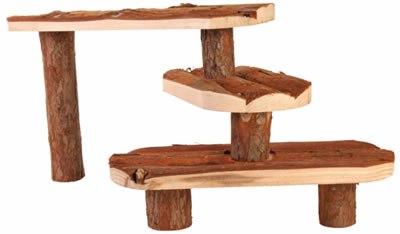Using fleece in your guinea pig's cage seems dead simple: Buy a few yards of thick fleece, put it in the piggie's cage, and every two days or so, shake/clean it out. Around the third or fourth day, you wash it, and in goes a second piece of fleece. In theory, it seems simple, but actually, it varies among guinea pig owners. Some like it to look super meticulously clean, while others don't mind if the pig gets messy a bit. There is a great overview of the stuff on the GuineaPigCages.com forum, called The Fleece Project: The Study. It covers purchasing, preparing and using fleece.
The Fleece Project recommends a Vacuum-Shake-Brush-Beat routine. I prefer a Brush-Shake-Baby Wipe-Air Dry-Shake routine for cleaning fleece. You probably have (or will have) your own favored routine. As I pull the fleece out of the cage, I sweep much of the debris into the cage with the hand held sweeping brush. All of this brushing often crushes some of the hay, so I find running the dust buster over it briefly can pull off the crumbs and any of the loosened hair. Then I shake the remaining, stubborn bits outside followed by the baby wipe where there's urine. Then I drape it over a patio chair and let it air-dry for a bit, which removes any other hairs or hay bits and makes it less wet.
If the weather is good, I do all of this outdoors, because the hair and hay bits will just blow away. Plus, I don’t have to sweep up the floor when I’m done. Less dust in the house, too. It takes some time and effort, but the results are impressive. You can see the difference with Willow’s fleece.
I have found that thin fleece is better to wick away the urine, and is easier to clean during this process. Polar fleece is downright impossible, but it does absorb well. The reason I use thinner fleece because I only have one pig, but if your guinea pigs are masters at using the bathroom all over the place, or you have a tricky cage base(if it's the kind that absorbs the urine easily) add towels underneath and a puppy pad or two. It takes some time and effort, but the results are impressive. You can see the difference with Willow’s fleece. The prep-work also makes the washing machine (and my mom) a whole lot happier. It doesn’t need to be wiped down after a load of piggy fleece. As an added bonus, if I dry the fleece in the dryer, the lint trap doesn’t look like half a guinea pig was shaved into it. :)
Washing
Even if you use the tecniques described above, your pig's fleece still needs to be washed twice or even three times a week. Pretty much everyone agrees that vinegar is great for removing urine and odor from fleece. Beyond that, laundering techniques can vary as much as the prep-work.
If you pour in about 1/2 to 1 cup of vinegar, a scoop of OxiClean and maybe a drop of detergent with a large load of pig fleece, it gets rid of odors and icky urine stains. Some washers have an extra rinse options, so if yours does, use that and run with warm/cold water (instead of hot). Fleece doesn’t hold onto the water, so you can just leave it out to dry.
That’s my basic cleaning routine. Nothing complicated. I sweep daily with a sweeping brush or the lightly with the rubber mitt. I do the Brush-Shake-Baby Wipe-Air Dry-Shake thing every few days. Fleece that is dry, clean and doesn’t smell may go back in the cage; stuff that needs washing goes in the hamper. I run a load whenever the hamper is full or when I’m on my last set of clean fleece for the cage. Your mileage will vary, based on number of pigs, their habits, humidity, cage setup (including what you use under the fleece) and your personal sense of what’s clean or not.
Willow's fleece: before and after



